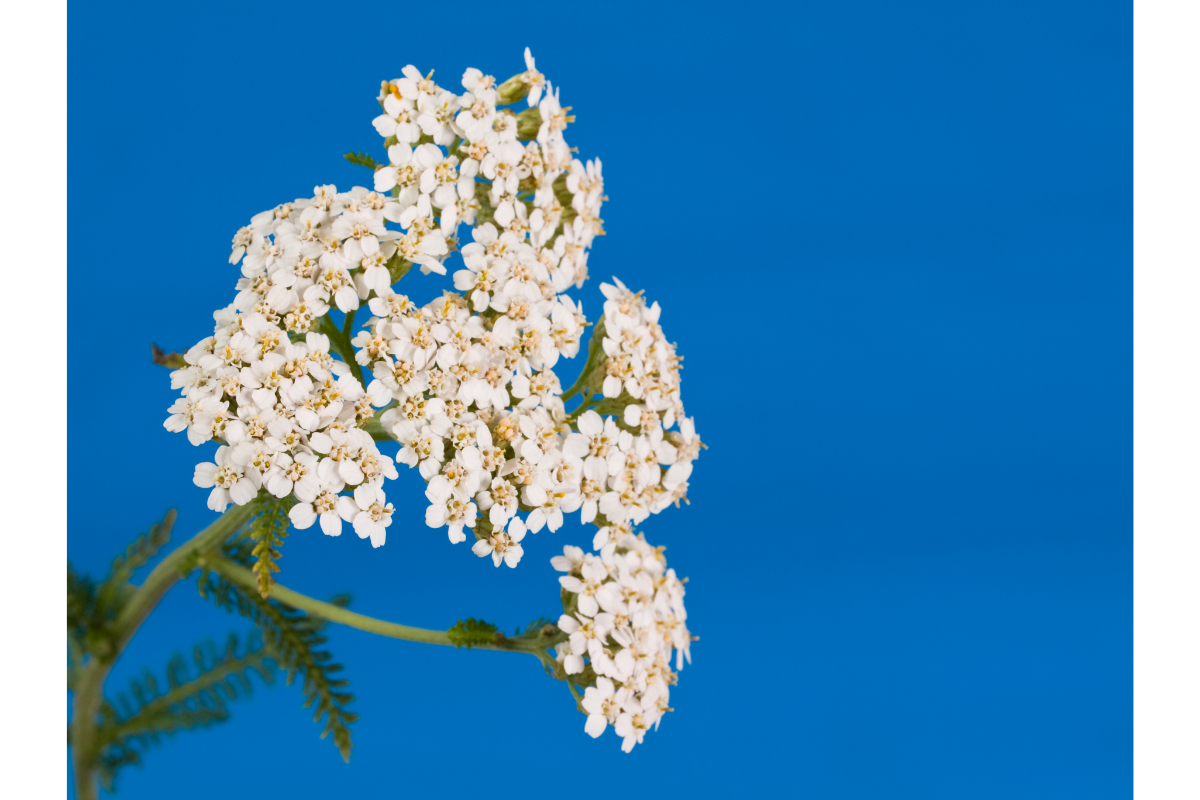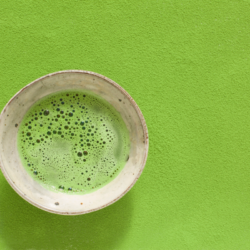We are all on a quest for health and well-being. Sometimes the answers to our questions can be found in nature, and in particular in a magical plant called yarrow. You may be asking yourself,“What are the properties of yarrow?” You’ve come to the right place for detailed and precise answers. This comprehensive guide will give you an in-depth insight into the benefits of this fascinating plant.
History of yarrow
Before we go into more detail about “what are the properties of yarrow”, it would be interesting to understand where it comes from. Its history dates back to ancient times, and it bears the traces of a rich and fascinating cultural heritage.
According to Wikipedia, the name yarrow is closely linked to Greek mythology. It owes its name to Achilles, the famous Greek hero of the Trojan War. According to legend, it was the centaur Chiron, known for his knowledge of medicine, who taught Achilles about the virtues of this plant. He used it to treat the wounds of his soldiers, making yarrow a symbol of healing and protection.
But yarrow’s journey did not stop in ancient Greece. Over the centuries, this plant has crossed the centuries and civilisations, and its use has spread throughout the world. In Europe in the Middle Ages, it was often used for its digestive and anti-inflammatory properties. In North America, certain Amerindian tribes used it to treat headaches and toothache. Today, yarrow is still appreciated for its many virtues. It continues to be used in phytotherapy, aromatherapy and even cosmetics. Its history, deeply rooted in our cultural heritage, bears witness to its richness and versatility.
Botanical description
Yarrow, commonly known as Achillée millefeuille, is a plant which fascinates by its botanical complexity and robustness. Native to temperate regions of the northern hemisphere, this perennial herb stands out for its ability to adapt to a variety of ecosystems, from open meadows to forest edges and sandy areas.
General morphology
Yarrow generally reaches a height of 30 to 60 centimetres, although some varieties can grow taller under optimal conditions. The stem, which emerges from an extensive rhizomatous root system, is typically erect, firm and often branched, bearing multiple flower heads.
Leaf structure
Yarrow leaves are particularly notable for their dissected shape. They alternate along the stem and are dark green in colour. Each leaf is divided into multiple small segments (hence the term “millefeuille”), creating a feathery appearance. This configuration increases the leaf surface area, optimising photosynthesis while minimising evapotranspiration.
Floral characteristics
Yarrow generally flowers from June to September. The flowers, which are small and numerous, are grouped in compact flower heads forming a flattened corymb at the top of the stem. Each flower head is made up of white or pink ligulate flowers surrounding central yellow tubulate flowers. This arrangement encourages pollination by a variety of insects, including bees and butterflies, which are attracted by the complex structure and colour shades of the flowers.
Ecological adaptations
Yarrow is renowned for its resilience and ability to thrive in poor soil and drought conditions. Its deep roots enable it to extract water and nutrients from poorly fertile areas, while its finely divided leaves reduce water loss, which is crucial to its survival and growth in arid environments.
What are the properties of yarrow?
Ready to unravel the mystery of yarrow? Let’s delve into the fascinating world of this plant and discover its impressive properties. Follow me on this exciting exploration.
Medicinal properties
Yarrow is a veritable natural pharmacy. It has anti-inflammatory, antispasmodic and astringent properties. Yarrow is also renowned for its beneficial properties for the digestive system and the skin. Let’s find out more.
Anti-inflammatory and healing
Yarrow, with its many virtues, has long captured the hearts of natural medicine enthusiasts. Its most notable quality is undoubtedly its anti-inflammatory and healing potential. But how does it actually work? Hang on, we’re about to get to the heart of the matter.
One of the active components of yarrow is azulene. This substance is renowned for its soothing effects and is often used in dermatology to calm various skin irritations. Whether you’re struggling with sensitive skin, itching or redness, azulene provides fast, effective relief. In addition to its anti-inflammatory effects, azulene plays a crucial role in the healing process. When applied as a poultice, yarrow promotes the repair of skin tissue, speeding up the healing of small wounds. It is particularly useful for cuts, abrasions and minor burns.
But that’s not all. Yarrow also has beneficial effects on mucous membranes. Mucous membranes, found in many areas of the body such as the mouth, nose and intestines, are often exposed to various irritants. By calming inflammation, azulene helps to protect and repair these delicate mucous membranes. In addition to its healing and anti-inflammatory properties, yarrow is also known for its antispasmodic and digestive benefits. It’s a highly versatile plant with a lot to offer. Let’s take a closer look at these aspects.
A natural antispasmodic
Yarrow is recognised for its effectiveness as an antispasmodic. It acts on the nervous system to relax muscles, which can be particularly useful in cases of menstrual pain. It can help relieve the cramps and abdominal pain often associated with menstruation. It is an invaluable ally for many women seeking to alleviate these symptoms naturally.
What’s more, this plant is beneficial for relieving digestive spasms. Whether you’re struggling with stomach cramps or intestinal pain, yarrow can provide significant comfort.
A digestive stimulant
Yarrow not only soothes pain, it also plays an active role in stimulating digestion. It promotes the proper functioning of our gastrointestinal system, contributing to better absorption of nutrients. Yarrow also has a beneficial effect on a number of common digestive disorders. It helps to combat bloating and flatulence, providing relief for those who suffer from these discomforts.
Contraindications : Precautions to be taken with Yarrow
It’s important to note that certain precautions need to be taken when using yarrow, even though it has many benefits. As with any medicinal plant, it’s crucial to follow certain contraindications if you want to use it safely.
- Allergies: Some people may be allergic to yarrow. If you are using it for the first time, it is recommended that you have a skin test to check your tolerance.
- Pregnancy and breast-feeding: Although yarrow can help relieve menstrual pain, it is not recommended for pregnant and breast-feeding women, as it can stimulate the uterus and therefore induce premature contractions.
- Autoimmune diseases: People with autoimmune diseases such as lupus, multiple sclerosis or rheumatoid arthritis should avoid yarrow, as it could potentially stimulate the immune system and worsen symptoms.
- Medication: Yarrow may interact with certain medications. For example, people taking anticoagulants should avoid it because of its anti-platelet effect.
If in doubt, always consult a health professional before using this plant, especially if you have a specific medical condition or are taking medication. Nature is generous, but you need to approach it with caution and respect.
Current research on Yarrow
Yarrow (Achillea millefolium) has been the subject of numerous recent scientific studies, highlighting its pharmacological properties and its potential in various therapeutic areas. This research is mainly exploring its bioactive components, its anti-inflammatory and antimicrobial potential, and its possible applications in the management of chronic diseases.
Bioactive components
Recent phytochemical studies have identified several key components of Yarrow, including sesquiterpene lactones, flavonoids and essential oils. These compounds are known for their anti-inflammatory and antioxidant properties. A study published in the Journal of Ethnopharmacology details how extracts of this plant modulate the biochemical pathways involved in inflammation and immune response.
Anti-inflammatory potential
Research published in “Phytotherapy Research” has shown that azulene, a component of Yarrow essential oils, has significant effects on reducing inflammation in animal models. These results suggest a potential application in the treatment of inflammatory conditions such as arthritis.
Antimicrobial activity
The antimicrobial efficacy of Yarrow has also been validated by recent studies. A publication in “Antimicrobial Agents and Chemotherapy” examined the effect of extracts of this plant against drug-resistant bacteria, including methicillin-resistant Staphylococcus aureus (MRSA). The results indicate significant inhibitory activity, which could be crucial for the development of new therapies against resistant infections.
Chronic disease management
Research is also exploring the role of Yarrow in the management of chronic diseases. A study in “Clinical Nutrition” found that the plant’s flavonoid components could help reduce biomarkers of oxidative stress in patients suffering from cardiovascular disease, offering a potential avenue for the prevention and treatment of these conditions.
These recent studies not only confirm some of the traditional uses of Yarrow, but also open up new avenues for future medicinal applications. The convergence of scientific validation and traditional use enriches the knowledge base enabling the full potential of this plant to be exploited in modern healthcare contexts.
FAQ
Q1: What is Yarrow and to which family does it belong?
A1: Yarrow is a perennial herbaceous plant in the Asteraceae family. It is characterised by its small white to purplish flowers and finely dissected leaves.
Q2: When does Yarrow flower?
A2: It flowers from June to September.
Q3: What are the common names for Yarrow and why are they called that?
A3: Yarrow is also known as cutwort, bleeding-wort, carpenter’s-wort, soldier’s-wort and nose-bleed. These names refer to its traditional use to treat wounds and injuries.
Q4: How can Yarrow be used in cooking?
A4: Its leaves can be served in salads or cooked after boiling. This removes some of their bitterness. They have also been used to flavour beer and the seeds have been added to wine barrels to preserve them.
Q5: What are the external and internal benefits of Yarrow?
A5: Internally, it is used to treat general fatigue, spasms of the digestive and uterine tracts, and circulatory disorders, among others. Externally, it is used for rheumatic pains, dermatitis, leg ulcers, etc. It is also recognised for its tonic, antispasmodic and haemostatic properties.





